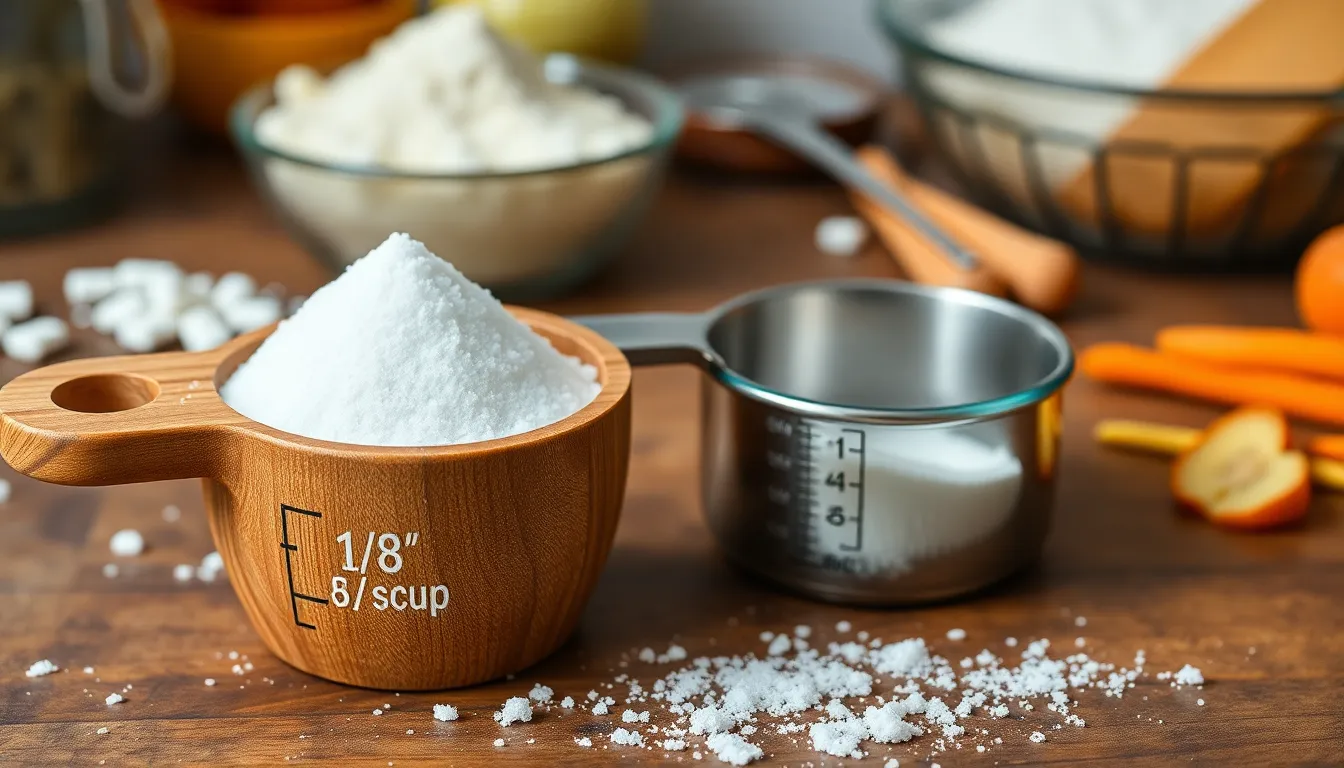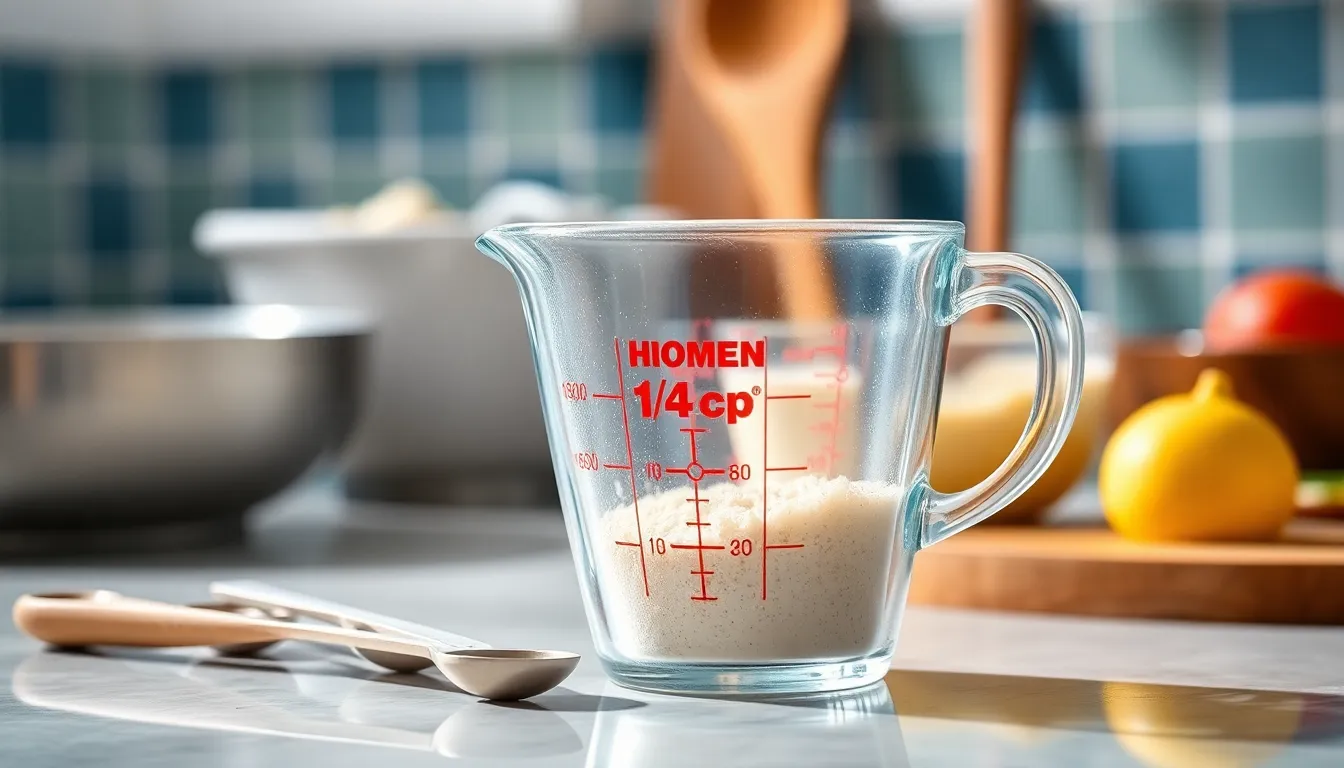Cooking often requires precise measurements, and understanding fractions can make a big difference in the kitchen. For those wondering what’s half of 1/4 cup, this simple calculation can help ensure recipes turn out just right. Whether you’re baking a cake or whipping up a savory dish, knowing how to halve measurements is a crucial skill.
When it comes to measuring ingredients, even small amounts matter. Half of 1/4 cup might seem trivial, but getting it right can enhance flavors and textures. This article will break down the math and provide practical tips for measuring ingredients accurately, making cooking and baking a breeze.
Table of Contents
ToggleUnderstanding Cup Measurements
Precise measurements are vital in cooking and baking. Knowing how to halve ingredients, like 1/4 cup, enhances recipe execution and ensures consistency in flavor and texture.
Importance of Accurate Measurements
Accurate measurements directly impact the outcome of dishes. Inconsistent ingredient quantities can lead to altered flavors and textures, undermining a recipe’s success. Proper measurement fosters culinary precision, allowing cooks to replicate their favorite dishes successfully. Understanding fractions also aids in adjusting serving sizes, ensuring recipes yield the desired amount without waste.
Common Cooking Conversions
Familiarity with common cooking conversions streamlines the cooking process. Here are crucial conversions for cup measurements:
| Measurement | Equivalent |
|---|---|
| 1 cup | 8 fluid ounces |
| 1/2 cup | 4 fluid ounces |
| 1/3 cup | 2.67 fluid ounces |
| 1/4 cup | 2 fluid ounces |
| 1 tablespoon | 0.5 fluid ounces |
| 1 teaspoon | 0.167 fluid ounces |
Understanding these conversions allows cooks to easily adjust recipes and scale ingredient quantities accurately, ultimately improving their cooking skills.
What’s Half of 1/4 Cup?

Half of 1/4 cup equals 1/8 cup. Understanding this conversion helps in maintaining accuracy in recipes and achieving the desired results.
Mathematical Explanation
Calculating half of 1/4 cup involves simple fractional math. To find half of a fraction, multiply the numerator by 1 and keep the denominator the same. Thus, half of 1/4 cup is:
- 1/4 × 1/2 = 1/8 cup
This mathematical operation establishes a clear relationship between fractions, ensuring correct ingredient proportions.
Practical Applications in Cooking
Using accurate measurements is crucial for flavor and texture. Here are practical scenarios where knowing half of 1/4 cup benefits cooking:
- Baking Cookies: Recipes may call for 1/4 cup of sugar. Halving this amount results in 1/8 cup, ideal for creating a less sweet version.
- Sauces and Dressings: Many sauces utilize 1/4 cup of vinegar. Using 1/8 cup allows for a milder taste adjustment.
- Scaling Recipes: When halving a recipe serving six to three people, precise measurements, including half of 1/4 cup, ensure consistent results.
Understanding these applications enhances cooking skills, ultimately leading to improved recipe execution.
Alternative Measurement Methods
Understanding various measurement methods enhances accuracy in cooking. Utilizing tablespoons and visual references offers practical tools for measuring small quantities.
Using Tablespoons
Using tablespoons simplifies measuring out fractions. One standard tablespoon equals 1/16 cup. To determine half of 1/4 cup using tablespoons, follow this calculation:
- 1/4 cup equals 4 tablespoons.
- Half of 4 tablespoons equals 2 tablespoons.
Thus, half of 1/4 cup translates to 2 tablespoons, providing a quick and easy alternative measurement for recipes.
Visual References
Visual references help in estimating measurements when tools are unavailable. Everyday items can serve as guides:
- A standard coffee mug: Typically holds 1 cup.
- A standard egg: Roughly equates to 1/4 cup when beaten.
- A small fist: Often resembles a 1/2 cup measurement.
Utilizing these visual cues aids in accurate ingredient portioning, enhancing recipe execution without needing precise measuring tools.
Tips for Accurate Cooking Measurements
Accurate cooking measurements play a crucial role in recipe success. Using the right tools and avoiding common mistakes ensures consistent results every time.
Tools You Might Need
- Measuring Cups: Use standard measuring cups for dry and liquid ingredients. Dry cup measurements are designed for solids, while liquid cups accommodate liquids.
- Measuring Spoons: Keep a set of measuring spoons handy for small quantities. They often come in 1 tablespoon, 1 teaspoon, and 1/2 teaspoon sizes.
- Digital Scale: Utilize a digital scale for precise weight measurements. It’s especially useful for ingredients that vary in density, like flour versus sugar.
- Liquid Dropper: Get a dropper for precise liquid measurements, particularly in recipes using extracts or flavorings.
- Adjustable Measuring Cup: Consider an adjustable measuring cup for versatility. It aids in measuring ingredients like sticky substances, such as honey or molasses.
Common Mistakes to Avoid
- Eyeballing Measurements: Avoid guessing amounts, as it can lead to inconsistencies. Stick to precise measurement tools.
- Incorrect Measuring Techniques: Measure dry ingredients using the scoop-and-level method. For liquid, always use a clear measuring cup with measurement lines.
- Ignoring Temperature: Be aware that ingredient temperatures can affect measurements. Room temperature ingredients mix more evenly than cold ones.
- Neglecting Conversion Factors: Stick to established conversions. Remember that 1/4 cup is equivalent to 4 tablespoons; miscalculating this can alter a recipe’s flavor.
- Overpacking Ingredients: Avoid packing ingredients like flour into a measuring cup. This method increases density and alters the recipe’s balance.
Mastering the art of measurement is crucial for anyone who enjoys cooking or baking. Knowing that half of 1/4 cup equals 1/8 cup empowers cooks to adjust their recipes with confidence. This understanding not only enhances flavor control but also ensures consistency across dishes.
Utilizing practical tools and methods simplifies the process of measuring ingredients accurately. By avoiding common mistakes and embracing precise techniques, cooks can elevate their culinary skills. Whether it’s adjusting a sweetener in a dessert or balancing flavors in a sauce, these small adjustments can make a significant difference in the final outcome. Embracing these principles will lead to more successful and enjoyable cooking experiences.





